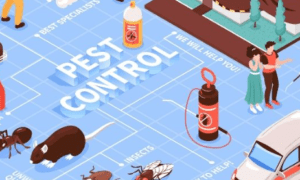Pest infestations are a serious concern for homeowners and business owners alike. Whether it’s ants invading your kitchen, termites eating away at your wooden structures, or rodents causing damage to your property, pests can create havoc in your home or business. A professional pest inspection is essential in identifying these issues before they become more serious, allowing you to take preventative measures early on. In this article, we will explore what you can expect during a professional pest inspection and why it’s important for protecting your property.
Why a Professional Pest Inspection is Crucial
A professional pest inspection serves as a comprehensive checkup for your property, identifying current pest problems and detecting potential future risks. Pest control is not just about eliminating visible pests; it’s about understanding the environment that allows them to thrive and preventing future infestations. Professional pest inspections are particularly important because they can uncover hidden issues that might not be immediately visible to an untrained eye.
Regular inspections help protect your property, safeguard your health, and avoid costly repairs that could arise from unchecked infestations. Without professional help, it can be difficult to know where to begin when trying to eliminate pests, or even worse, you may miss an infestation until the damage is done.
The Process of a Professional Pest Inspection
Understanding what happens during a professional pest inspection can help you feel more prepared when the Largo pest control expert arrives. Here’s a breakdown of the process and what you can expect:
1. Initial Consultation and Assessment
When a pest control expert arrives at your property, they typically begin with an initial consultation to assess your needs. During this phase, the technician will ask you questions about any current pest problems you’ve noticed, such as sightings of insects or rodents, unusual smells, or visible damage to your property. You will also have the opportunity to mention any specific concerns, such as areas that you feel are more susceptible to infestations.
This conversation is essential in giving the inspector a better understanding of where to focus their attention during the inspection. They will use your input to direct their examination of your home or business.
2. Thorough Property Inspection
After gathering information from the initial consultation, the pest control expert will conduct a detailed inspection of both the interior and exterior of your property. This step usually includes:
- Interior Inspection: The technician will examine all rooms in your home or business, paying special attention to areas like the kitchen, attic, basement, bathrooms, and any other places that might attract pests. They will look for signs of pests such as droppings, webs, nests, and evidence of damage to furniture, walls, or electrical wiring.
- Exterior Inspection: The technician will inspect the outer structure of the building, checking for cracks or openings that could serve as entry points for pests. They will assess the condition of the foundation, windows, doors, rooflines, and vents to ensure they are secure. Additionally, they will inspect your yard and any nearby structures for nests or breeding grounds.
- Identification of Risk Factors: One key element of a professional pest inspection is identifying potential risk factors that could attract pests. These could include standing water, leaks, food sources, and poor ventilation. The inspector will make note of these and offer suggestions for how to mitigate these conditions to prevent future infestations.
3. Assessment of Hidden Infestations
One of the most valuable aspects of a professional pest inspection is its ability to detect hidden infestations. Pests like termites, ants, and rodents often make their way into hidden spaces where they are not easily detectable. A skilled pest control technician will know exactly where to look and what signs to watch for.
- Termites and Wood-Destroying Insects: The technician will check for signs of termites or other wood-destroying insects. This might include visible damage to wooden structures, mud tunnels, or the presence of discarded wings near windowsills or doors.
- Rodents: If there are signs of rodents, the technician will check areas like crawlspaces, attics, and basements where rodents like to hide. They will look for droppings, gnaw marks, or nests that might indicate an infestation.
- Ants, Roaches, and Other Insects: Common household pests such as ants or cockroaches can often be difficult to spot. The pest inspector will check for tiny trails of ants, cockroach egg casings, and other tell-tale signs of an infestation.
4. Inspection Report and Recommendations
Once the inspection is complete, the technician will provide you with a detailed report. This will outline the findings of the inspection, including any active pest problems and potential threats. The report will also include recommendations for treatment, if necessary, and steps you can take to reduce the likelihood of future infestations.
The recommendations may include:
- Sealing cracks or gaps in your property
- Installing screens on windows or vents
- Improving ventilation or drainage to prevent moisture buildup
- Removing food or water sources that attract pests
If pests are found, the technician will discuss treatment options with you, such as the application of pesticides, bait stations, or traps.
Why Regular Pest Inspections Matter
Now that you know what to expect during a professional pest inspection, it’s important to understand why having inspections on a regular basis is crucial for maintaining the health and safety of your property.
1. Early Detection Saves Money
The earlier a pest problem is detected, the easier and less expensive it is to fix. Many pests, like termites, can cause severe structural damage to your property if left unchecked. Catching these issues early can help you avoid expensive repairs in the future.
2. Health and Safety Concerns
Pests like rodents and cockroaches can carry harmful diseases and allergens, which can negatively affect your health. Regular pest inspections can help ensure that your home or business is safe from these potential health hazards.
3. Preserve Property Value
Regular pest inspections help preserve the value of your property. Pest infestations can damage your home’s structure, electrical systems, and even its aesthetic appeal. Addressing problems early ensures that your property maintains its value over time.
4. Peace of Mind
Knowing that your property is pest-free provides peace of mind. You can rest easy knowing that a professional has inspected your property thoroughly and taken steps to ensure that it remains safe from pests.
About Pest Control Solutions & Services
Pest Control Solutions & Services is dedicated to providing high-quality pest control Largo FL services in Largo, FL, and surrounding areas. We understand the importance of keeping your home or business free from pests, which is why we offer comprehensive pest inspections, treatment plans, and ongoing maintenance services. Whether you’re dealing with termites, rodents, or any other pests, our expert team is here to help.

































